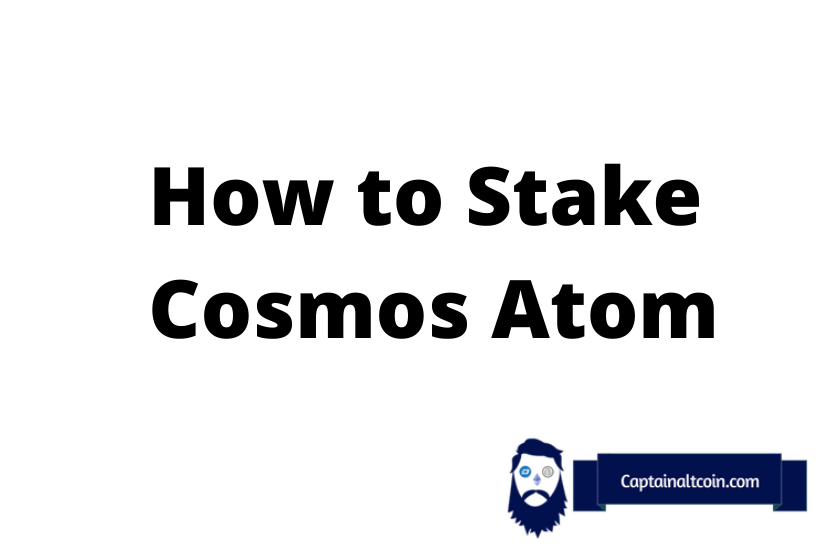
Staking refers to the process of holding cryptocurrencies in a wallet or an exchange to support blockchain operations and earn rewards in return. Cosmos uses a hybrid Proof-of-Stake mechanism to offer an all-in-one solution to all scalability and interoperability challenges that have been affecting the blockchain industry.
It is a unique blockchain powered by a native cryptocurrency called Atom, and its main objective is to integrate several blockchains into a single hub-the Cosmos Hub. It is this hub that connects several blockchains together in a single network. Staking Cosmos is a popular way for Atom holders to earn free cryptocurrencies without investment.
| 🔑 Step | Details |
|---|---|
| 💰 Get some ATOM | You can purchase ATOM from an exchange or exchange it from another cryptocurrency within your wallet. |
| 🌐 Choose a staking platform | Several platforms allow ATOM staking, including Exodus, Ledger, Atomic Wallet, Coinbase, Binance, and Kraken. |
| 🔗 Connect your wallet | Depending on the platform, you may need to connect your wallet using a browser extension or a mobile app. |
| 👥 Delegate your ATOM | After connecting your wallet, delegate your ATOM to a validator node. Validators use your ATOM for consensus participation and earning rewards on your behalf. Choose a validator based on commission fees, uptime, and reputation. |
| ⏳ Wait for rewards | Rewards depend on the staked ATOM amount, staking duration, and validator performance. You can periodically claim and withdraw these rewards to your wallet. |

What you'll learn 👉
What are Cosmos and Atom?
Cosmos is a group of independent blockchains designed by Tendermint Inc. The project was created as a next-gen internet model and the underlying idea is not to fragment the blockchain but to unite it. It is a good model of IoB or Internet of Blockchain. There are two main components that support staking Cosmos;
- The Tendermint core; is an open-source blockchain development platform that allows users to develop and launch any blockchain-based project.
- The Inter-Blockchain Communication (IBC) algorithm; is a set of instructions and protocols that bring the various blockchains together in a cluster. The cluster is the central hub and is composed of several blockchains that work independently but share the same structure.
The entire system is composed of different blockchains called zones and which are connected to a central hub. It is the central hub that runs the proof-of-stake algorithm to hold everything together. Each zone is made of several hubs used to validate and consolidate transactions. The proof-of-stake system is also designed to support hubs as well.
Why Stake Cosmos?
To build consensus, ATOM holders contribute their tokens to be used in validation of transactions. A select group of validators is chosen by other Atom holders to create the next block for the Cosmos blockchain and then rewarded for their work in Atoms.
In essence, Atom holders do not become validators themselves but instead delegate their assets to validators. This delegation is itself a vote on who should be among the validators and allow token holders to indirectly participate in validating transactions.
The Atom holder earns a commission of up to 10% for validating transactions on the network. The top 125 Atom holders with the most delegated Atoms become validators. Delegated Atoms cannot be used in transactions although the holder maintains full ownership.

To claim their reward, validators can either compound or cash in their accumulated Atom rewards. Compounding means re-delegating your newly acquired Atoms to increase your reward faster.
It refers to ploughing back your profits to generate more profit. On the other hand, cashing in means receiving the Atoms generated from the delegation. This means these Atoms are unlocked and can be accessed for transactions.
Types of Staking
There are three different categories of staking;
Staking groups
Staking groups are users who come together and pool their tokens to increase their chances of becoming validators. Pooling their tokens increase their staking power. The staking group gets the reward and share among the group members according to member contributions.
This method allows even those when few tokens to participate in staking and also contribute to decentralization.
Cold staking
Cold staking involves staking from a cold wallet. These are wallets that have no permanent internet connection. These types of wallets allow users to keep their coins offline and minimize the chances of fraud. It is preferred by high-volume investors that have large amounts of cryptocurrencies.
Staking Suppliers
Staking suppliers offer exclusive staking services to coin holders. The level of return from this form of staking largely depends on the commission charged which ranges between 2% and 50% of the earned reward.
The validator
A validator is a token holder who operates a node and wishes to participate in verifying transactions on the blockchain platform. On the Cosmos Hub, validators participate in consensus building through voting or publishing cryptographic signatures.
Delegator
Delegate stake their ATOMs through validators in return for a commission. A token holder can delegate his coins to one or more validators. Delegators not only share in the validator’s return, but they also bear the costs that may come from any future occurrences.
Before settling on a validator, you need to conduct careful due diligence to establish their reputation and protect their investment.
Read also:
- How To Stake Polkadot on Polkadot.js, Ledger, Binance, Crypto.com
- Where Can You Stake ALGO?
- Best Ethereum Staking Platforms & Pools
- How to Stake Synthetix
- Best Staking Exchanges, Wallets & Services
- How to Stake Coins on Binance?
- Best Staking Coins
- What Can I stake on Ledger?
- Tezos Staking Guide – 4 Ways & Places To Stake XTZ
- How to Stake on Crypto.com
- How to Stake on Kraken
How To Stake Cosmos – ATOM Staking Guide
Staking Cosmos is an easy exercise and takes a few simple steps. It is even easier if you have a Ledger wallet although it can also be done through the Cosmosstation mobile app.
👉 Step 1: Set up a wallet
Staking starts by setting up a wallet where the Atoms are held. This can be done on Ledger, MyEtherWallet, or the network’s Cosmostation mobile app. It is from the wallet that you conduct transactions and delegates your tokens for validations.
👉 Step 2: Back up your wallet
Ensure your wallet is backed up, you have a seed phrase and it is well stored. A seed phrase is a list of words with all information that you need to get your tokens from the wallet. They are generated by the wallet software and the user needs to have them access their tokens.
👉 Step 3: Delegate
After setting up and topping up your wallet, you can delegate your Atoms to validators and earn start earning rewards. The process is always simple although different wallets may have slightly different delegation procedures. Atom holders can delegate their tokens to one validator or spread them out among several validators to diversify.
👉 Step 4: Claim your reward
Your earned commission may not be deposited in your wallet directly and the users may have to place a claim. It is advisable to claim your reward regularly so as to increase your atoms’ compounding effect.
Common Staking Platforms
There are several platforms where atom holders can stake and earn rewards and passive income. The right platform ought to have superior features, high annual returns, less fee, and high-security features.
Ledger Wallet
Ledger is a software company that develops solutions for the storage of cryptocurrency assets. Launched in 2014, Ledger has its headquarters in Paris, France, and develops Ledger wallets that have bank-like security features for the storage of digital currencies. The company is the brainchild of eight experts with backgrounds in entrepreneurship, cryptocurrencies, and embedded security.
Binance
Binance is the world’s largest cryptocurrency exchange in terms of trade volume and boasts of millions of users across the world. The platform offers several unique features like earning rewards with loan and interest accounts, lending services, and cryptocurrency leverage trading.
Cosmos staking on Binance earns a reward of between 6% and 9% and the reward is paid every month. To qualify for staking rewards, Atom holders need to maintain a balance of at least 0.5 Atoms in the Binance wallet.
The biggest advantage of using Binance for staking is that users can stake Cosmos while at the same time waiting for a trade opportunity. This allows them to benefit from staking commissions as well as trade profits.
Coinbase
Coinbase is one of the leading cryptocurrency exchanges with more than 35 million users in more than 100 countries around the world. The exchange supports the trading, use, and staking of Bitcoin and other digital currencies.
Coinbase offers staking of Cosmos (ATOM) only to US customers with returns of up to 5%. The percentage varies subject to staking profits from validators. To state Cosmos on Coinbase, one needs to first have Cosmos coins stored in a Coinbase wallet. A minimum of 1 ATOM is needed for staking. Staking rewards on Cainbase are paid after 7-14 days.
Atomic Wallet
Atomic Wallet is an online cryptocurrency wallet that supports up to 500 coins and is available both on desktop and mobile devices. ATOM holders on this platform earn up to 10% in returns for staking their coins. One needs to maintain a minimum balance of 1 ATOM in the Atomic Wallet to qualify for staking.
Benefits of Staking ATOM
Staking only becomes attractive when the commission paid out is more than the price increase or returns from trading the coin.
- Another opportunity to earn revenue; failing to stake is generally regarded as failing to seize an open opportunity. ATOM holders who choose not to delegate their coins to validators miss out on commissions paid out from the total profit earnings.
- Transaction fee income; transaction fees from each block are also paid to the token holder.
- Users who keep a large number of cryptocurrencies have higher chances of being selected as validators, giving them the power to verify new blocks on the blockchain network.
- Cryptocurrencies that are staked do not devalue with time as is the case with mining equipment that becomes obsolete when a new and better one is launched.
Are There Risks With Staking Cosmos (ATOM)?
The biggest undoing with staking Cosmos is that the investor loses control of his assets for some time. Although ownership is maintained, investors cannot trade or transfer ATOMs that have been committed for delegation. Cryptocurrency exchanges have been hotbeds of online fraud and have seen crypto holders lose millions in hackings, dubious deals, and online theft. Entrusting your investment to a third party can result in the potential loss of funds.
Staking platforms also deduct a percentage from the user’s staking reward which causes a decrease in the commission earned. The fee deducted ranges between 1% and 25% depending on the validator.
While the process of delegating your tokens to be used in return for rewards is eye-catching, the truth is that the actual amount paid out is not always much. The reward may therefore be very low compared to what is obtained from mining blocks.
Finally, the idea of delegating undermines decentralization that underscores cryptocurrencies. It is possible for some validators to get more delegated coins hence the power to generate blocks and make decisions is left in the hands of few people.
Factors to consider when considering staking
Below are few factors to take into account when considering staking;
- Do thorough research about the cryptocurrency to stake, the platform where to stake, the right validators to delegate.
- Determine beforehand the amount of return you project from staking
- Select a strong cryptocurrency that will guarantee higher returns.







